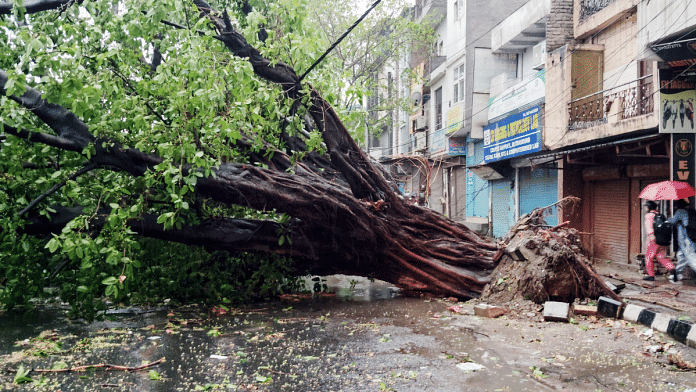New Delhi: A rare confluence of weather systems over Delhi-NCR led to intense rain and thunderstorms Friday, and caused the windspeed to peak up to 80 kmph in some pockets, the India Meteorological Department (IMD) said.
A senior Met department official said that thunder and dust storms, with light to moderate rain spells, are expected to continue over Delhi and its satellite towns through the weekend.
“Temperatures are likely to remain below 40 degrees Celsius at least on the first 10 days of May,” the official said, adding the mercury will start rising again after that.
Heavy rain, along with gusty winds, lashed Delhi-NCR in the early hours of Friday. The high-speed storm caused a house to collapse in the national capital, killing at least four people. Over a dozen trees were also uprooted and roads got waterlogged. Some flights were delayed.
Also read: What Delhi govt’s 2025 Heat Action Plan promises & what it misses
What caused the sudden rain?
IMD data showed that till 8.30 am, the Safdarjung observatory—the representative station—recorded 77mm of rainfall. This is the second highest single-day rainfall record for May since 1901. The record for the highest single-day rainfall was on May 20, 2021, when it was 119.3 mm.
At Lodhi Road, 78 mm rainfall was recorded Friday; at Ridge, 59.2 mm; and at the Aya Nagar weather station, 39.4 mm rainfall was recorded through the night. Squally winds hit Safdarjung at a speed of 80 kmph.
According to the IMD, this sudden weather change was due to a combination of factors involving moisture and wind patterns.
Mahesh Palawat, vice-president (meteorology and climate change) at Skymet Weather, a private weather forecasting agency, explained that two cyclonic circulations are currently active over the region. One, over Punjab, Haryana and northwestern Rajasthan, and the other over southwestern Rajasthan.
A cyclonic circulation is a pattern of winds that rotates around a low-pressure area.
This, along with intense rain-bearing cloud formation, due to increased heating in the region over the last few days, led to such heavy showers. “These clouds tend to cause heavy showers for shorter durations,” Palawat explained.
The IMD confirmed that the region experienced moisture and wind convergence from both the Arabian Sea and the Bay of Bengal. These conditions were further assisted by a synoptic pattern—a large-scale weather pattern typically observed on a weather map or chart—at the lower and middle tropospheric levels.
“The minimum temperatures have already dropped by a few degrees. In some pockets, the drop is as much as 5-6 degrees. Its effect will also be seen in the maximum temperatures,” a Met official said on Friday.
Climate experts said there has been a trend of erratic western disturbances in recent years, leading to extreme weather events.
“There is growing evidence that western disturbances are impacting weather outside the winter season, leading to extreme precipitation events. There is no doubt that increasing heat stress is the basis of everything, as it is generating more energy and at the same time pushing moisture upwards,” said professor AP Dimri, director of the Indian Institute of Geomagnetism.
(Edited by Ajeet Tiwari)
Also read: Everyone in north and central India must adapt to extreme heatwaves. Spring has vanished






